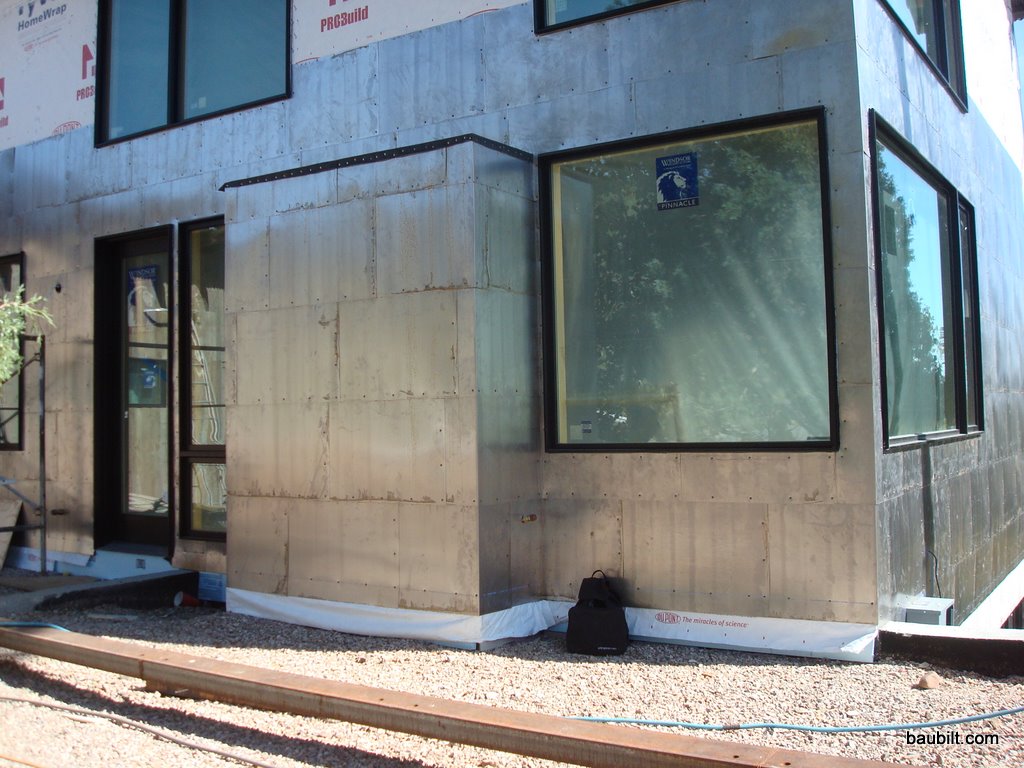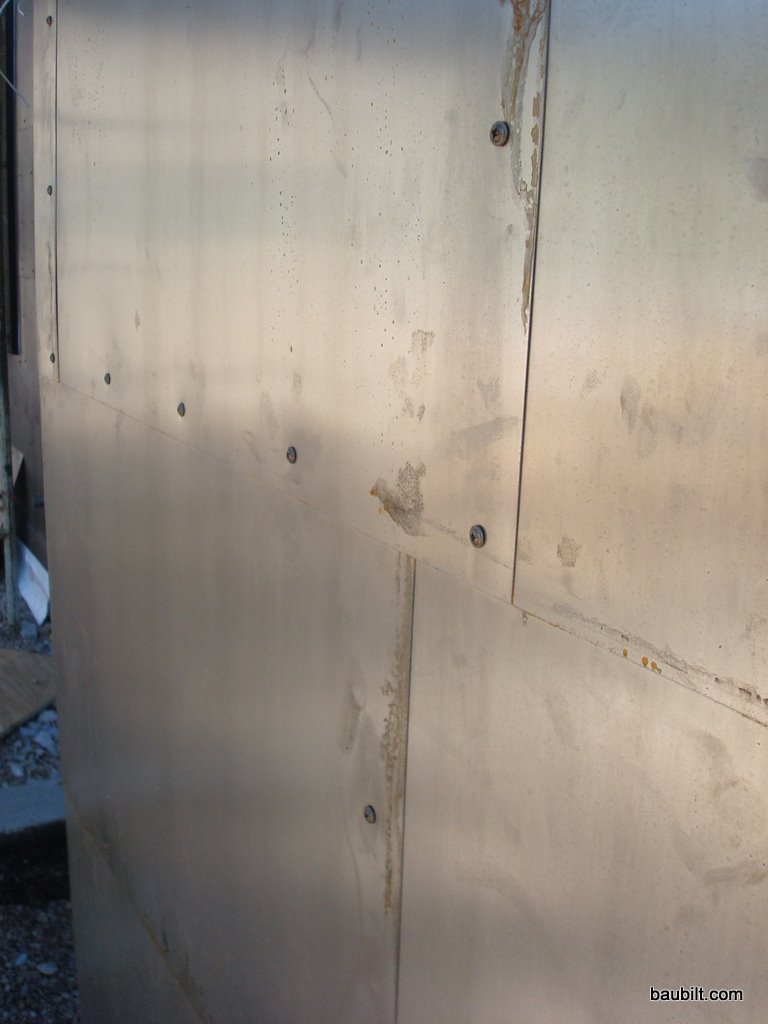The roofers have nearly completed the steel siding on the house. I’m very happy with the results. We are using 2′ x 3′ 20 gauge cold-rolled steel flat panels. It is very inexpensive (~$2/sq-ft materials and labor), and I think it looks fantastic. It will rust to a reddish brown when exposed the weather for a few months.





Here are some more pix from a week later.


Karl: I like the poorman’s steel siding! Is this an option in my Vermont barn in combo with local pine, or am I too wet there compared to Utah?
LikeLike
Hi Karl,
Your website is great! I am currently building a house in South Lake Tahoe. We are just about to order metal for our exterior siding, similar to your application. I was hoping you could answer me a couple of questions? Did you look into cor-ten vs. cold rolled steel? What did your roofer use to cut the sheets, I was thinking a metal blade on a skill saw would burn and discolor the cut edge? Did your guy use a metal sheer? Did you caulk behind each piece as they went up or at least the pieces around the windows? Thanks for you time, Brenton
Also, probably gonna steal your metal baseboard idea, love that against the concrete floors.
LikeLike
Brenton,
We used 20-gauge cold-rolled steel, not cor-ten. In the Park City climate, cold-rolled steel seems to last a century, even if on the ground. I know this because there is a lot of steel on old mining structures on the mountain near the house. Most people in the area do not use cor-ten. The same is apparently true in Jackson, WY where the architects live. I’m not sure how much wetter Tahoe is, but I’m guessing the summer humidity level is the key determinant of the corrosion rate.
My roofer had a heavy-duty shear (foot-pedal operated) on site. He also bought a 48″ wide heavy-duty brake to bend the corners. The usual light-duty flashing shears and brakes won’t work on this material. A circular saw would work, but would be noisy and fairly slow. I wouldn’t worry about the blackened edge. That’s going to rust pretty quickly. (Note, however, that the roofer ordered the material is 2′ x 3′ panel sizes. His supplier can bang those out on a power shear really inexpensively.)
We did no caulking. I would pay careful attention to the housewrap details (lapping, stapling, taping), but I don’t think you have to worry about sealing the steel panels. We lapped them 2 inches vertically and 3 inches horizontally. This seems much tighter than most wood siding. Plus, you want any moisture to be able to drain/evaporate out from between the house wrap and the siding. Around the windows I can see caulking, but mostly you are relying on the housewrap and window self-stick flashing to resist water.
Good luck.
-Karl
LikeLike
Enjoying your site… thanks Karl
Do you expect your steel siding’s or roof’s rust to impact any concrete or stonework outside… ie. patio, walkway, or driveway area?
LikeLike
I noticed that there are some rust marks on the driveway where water has run off the steel trim. I consider this “patina” and don’t mind it. There is also some rust coloration on the concrete pavers. Again, I don’t mind that. The only place where I’m somewhat worried about it is on the black anodized window frames and on the concrete foundation walls below the steel on the gable end of the house. However, so far there has been no staining. Those gable walls are oxidizing very slowly (at least in Winter and Spring, and so I think they are very well protected from water by the deep overhang from the roof). I’ll post some updates as the walls weather.
LikeLike
Karl,
Fantastic house and website. I have really enjoyed all the info you have shared. I’m working on a cabin in sw montana at the moment and had planned on using this steel treatment for a few bumpouts in my wall. Thanks for all the details.
-isaac
LikeLike
I’m very late to this thread, but just in case you’re still checking comments, I have a question for you:
I notice that you’ve built in both the dry west and the more humid east, and I’m wondering if your method of installing barnboard siding varies by location. I may be mistaken, but it looks as thought you’re attaching the siding directly to the felt-covered sheathing, rather than to furring strips. Do you do the same thing in Vermont, or do you feel that more of a rainscreen approach is needed to help keep moisture out of your walls?
You have some beautiful projects and I’m glad I discovered your site!
LikeLike
In the West, we installed Tyvek house wrap and then black landscape fabric. The black fabric was just to prevent the white Tyvek from showing through gaps and knot holes. We installed the barnboard right over the landscape fabric.
In the East, I installed pine siding right over Tyvek. I stained both sides of the pine siding before installation. I did not use a rainscreen approach. I grew up in a house with pine siding over tar paper and it is doing fine 43 years after construction, so I don’t think the rainscreen is strictly necessary for a 40+ year life. I quite like some of the integrated housewrap and rainscreen products (there is one that is a black loose plastic mesh bonded to a Tyvek-like membrane made by Vaproshield). But, these products are pretty expensive. They probably increase the life of the siding, although I don’t know of any studies that actually show that. I’m sure you can get a similar effect with furring strips.
LikeLike
Hi….Our construction company in canada is sourcing this product for one of our clients, and we are having difficulty finding installation information….would you be able to send this to us or direct me to where we might find the installtion process for corten….
txs
Karin
NISSA ENTERPRISES LTD.
LikeLike
We installed as follows:
Over Tyvek
2′ x 3′ panels
lapped 3″ horizontally and vertically.
McFeely’s washer-head combo screw (plain steel finish).
(10 x 1-1/2 Wood Screws, Unplated Steel, Round Washer Head, Combo Drive)
You may want to experiment with length.
LikeLike
Also, we did not use Corten, given very arid Utah climate. So, we used just a plain steel screw. If you have moisture, then you will need to use Corten — and so you will want a different screw, too. Typically corten is installed with a painted (red/brown) roofing screw, I think.
LikeLike
Hello Karl,
I was wondering if you have any photos you could post of the Park City house with the steel siding? The house looks great and I would love to check it out as a finished product.
Thanks much.
Joe
LikeLike
These photos are of the finished house. However, the siding has weathered in a bit since these photos were taken:
LikeLike
Hello Karl,
I am an urban infill developer in San Diego and am currently putting together some specs for metal siding for my 21 unit apartment building. I love what you did here!
Will you please be so kind as to share with me your pattern for the fasteners? How far did you space them apart, etc.?
Also, did you fasten the panels directly into the side of the house or did you have any kind of channel system to provide an air gap in between?
Lastly, did you take any measures to mitigate against oil canning?
LikeLike
We lapped the panels 4 inches horizontally and 2 inches vertically. The screws are McFeely’s #10 x 1 in. washer-head combo-drive screws. The guys predrilled the top panel and then punch through the panel below it before driving the screws. You can see in the photo the approximate screw spacing. I believe it’s 8 inches. We applied the panels directly over the Tyvek housewrap. I don’t see a need for an air gap — Utah is very, very dry so there isn’t much need for a rain screen. I would expect the same for San Diego. The panels oil can a little bit in hot sun. But, it doesn’t seem to permanently distort the panel. You could probably oversize the holes a bit to let the panel float, but the little bit of oil canning has never bothered me.
LikeLike
Hello, Any adverse reactions between the steel siding and aluminum windows? Are they in direct contact anywhere or are they isolated via Bituthane flashing or similar? I’m planing on using Corten siding on much of my remodel in the San Francisco Bay Area and am slightly concerned about the dissimilar metal situation.
Thank you for any input, Ryan
LikeLike
I just took a careful look and don’t see any evidence of galvanic corrosion. The steel panels generally do not touch the aluminum on the windows. in my case the window frame protrudes enough that the edge of the window that would contact the steel is actually plastic. However, in the few places where the steel does touch aluminum, there is no evidence of corrosion. This is after 8 years, but Utah is a very dry climate, which I’m sure inhibits any potential galvanic action.
LikeLike